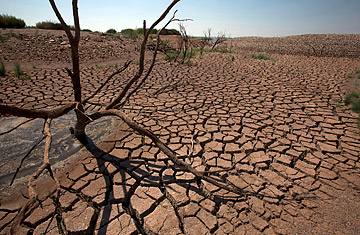
A parched lake in Texas illustrates the effects of a record-breaking drought that hit the state and much of the American Southwest this year
Earlier this month, officials in the South Pacific island nation of Tuvalu had to confront a pretty dire problem: they were running out of water. Due to a severe and lasting drought, water reserves in this country of 11,000 people had dwindled to just a few days' worth. Climate change plays a role here: as sea levels rose, Tuvalu's groundwater became increasingly saline and undrinkable, leaving the island dependent on rainwater. But now a La Niña–influenced drought has severely curtailed rainfall, leaving Tuvalu dry as a bone. "This situation is bad," Pusinelli Laafai, Tuvalu's permanent secretary of home affairs, told the Associated Press earlier this month. "It's really bad."
So far Tuvalu has been bailed out by its neighbors Australia and New Zealand, which have donated rehydration packets and desalination equipment. But the archipelago's water woes are just beginning — and it's far from the only part of the world facing a big dry. Other island nations like the Maldives and Kiribati will see their groundwater spoil as sea levels rise. Texas, along with much of the American Southwest, is in the grip of a truly record-breaking drought — even after days of storms in the past month, Houston's total 2011 rainfall is still short of its yearly average by a whopping 2 ft., or 60 cm. Australia has experienced severely dry weather for so long, it's not even clear whether the country is in a state of drought, or more worryingly, a new and permanent dry climate that could forever alter life Down Under. "Climate-change impacts on water resources continue to appear in the form of growing influence on the severity and intensity of extreme events," says Peter Gleick, one of the foremost water experts in the U.S. and head of the Pacific Institute, an NGO based in Oakland, Calif., that focuses on global water issues. "Australia's recent extraordinary extreme drought should be an eye-opener for the rest of us."
Volume 7 of the Pacific Institute's regular report on global water usage, The World's Water, comes out today, just in time to address the squeeze of droughts, the increasingly apparent impact of climate change and the threats facing our relatively scarce supplies of freshwater. The sweeping report is a reminder that clean water is vital to life — as Gleick points out, more than 2 million people die each year from preventable water-related diseases — and that on the whole, we're not doing a very good job of husbanding that resource. There's even a risk here that parts of the U.S., especially the arid West, may have passed "peak water" — the point at which it becomes essentially impossible to increase supply.
Potential water shortages are one more reason to try to reduce carbon emissions and blunt the worst impacts of climate change — a warmer world is likely to further dry out already arid regions, even as extreme rainfall intensifies in already wet areas. But however severe the effects of climate change become, we're going to need to use water much more efficiently than we do now: the world's population is expected to pass the 7 billion mark by the end of this month, and more people will need more water. "New thinking about solutions and sustainable water planning and management, better data, case studies and efforts to raise awareness, are all needed," Gleick writes in The World's Water.
Smarter water policy might mean rethinking other fields of resource use. Take, for example, natural gas drilling. Hydraulic fracturing has vastly increased American supplies of natural gas, which is good for gas companies and, because natural gas generally has a greener footprint, potentially good for the environment as well. But fracking requires a significant amount of water — up to 5 million gal. (19 million L) per well. That might not be a major problem in a relatively wet state like Pennsylvania, but in bone-dry states like Texas, water-intensive fracking has sparked a backlash. There's also the uncertain risk of water contamination from fracking and drilling, and the problem of water waste. "The rapid expansion of the use of hydraulic fracturing to increase natural gas production has serious potential consequences for local water resources," says Gleick. It's important that "more effort be put into both understanding the real risks and protecting water resources before pushing for accelerated programs of natural gas production."
What we need most of all is a rethink of how we deal with water and a recognition of just how valuable it is — especially in a warming world. That means focusing on modulating demand as much as increasing supply. Through most of the 20th century, governments dealt with water problems through massive construction projects designed to expand and regulate supply — think the Hoover Dam near Las Vegas or the Three Gorges Dam in China.
But the era of those big projects may be ending, largely because we've begun to recognize the environmental problems that come with major dams, including the loss of aquatic wildlife and the displacement of local populations. Last month Burma's military government — not ordinarily responsive to public opinion — canceled a planned $3.6 billion Chinese-backed hydroelectric dam that would have displaced thousands of villagers. Just as we've recognized that energy efficiency is often the fastest and cheapest way to address carbon emissions, there's much that can be done to curb water waste. We need to "adopt 21st century strategies of new forms of sustainable water supply, rethink water demand and efficiency of use, and [embrace] smart use of pricing and economics," says Gleick. The alternative could mean ending up like poor Tuvalu — high and dry.
